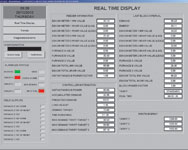

Silicon Technology is situated at Ballengeich, south of Newcastle, in northern KwaZulu-Natal. The plant produces ferrosilicon, an alloy of iron and silicon, for the steel industry where it is used in the refining of steel. The plant has two furnaces, a raw material system and the final products crushing and screening plant and is a large consumer of power, resulting in the company paying large charges to Eskom.
The monthly energy bill forms a significant part of Silicon Technology’s production costs so it engaged Autotronix to replace the existing energy management system with a new Mitsubishi PLC-based system with a Wonderware scada to display and report on energy consumption. In order to improve the control system even further, Silicon Technology identified that the furnace could be optimised to reduce energy consumption. To ensure seamless communication and integration, regular project technical meetings were held where progress was evaluated.
Autotronix has an existing relationship with Silicon Technology, having been responsible for the design and installation of the old control system in 1993. This time, the scope of the work was multidisciplinary and ranged from designing, programming, installing and commissioning the system so that it could be operated on both local HMI and remote scada via Ethernet.
During the design of the functional specification, Silicon Technology’s instrument technician, Mike Banks, and maintenance engineer, Tinus Van Greuning, provided valuable input that had a direct influence on critical design decisions. The design was in fact derived from the Autotronix standard energy control software, modified for Silicon Technology with the cooperation of Banks. Silicon Technology also requested that the international IEC 61131 standard PLC language be used for programming the software.
Autotronix converted its existing energy management software for the PLC using the Mitsubishi GX IEC 1131.3 programming software with detailed documentation generated to explain the operation and functionality. New graphics were developed to display plant status information to the operators and to enable the operators to control the plant more easily. The existing industrial fibre-optic Ethernet network was used for the PLC and scada communication, allowing easy connectivity to other equipment and computers in the plant.
The plant gets billed according to the Eskom 3-part tariff – consumption and maximum demand, so the controller’s primary job was to maintain the plant demand at the target set by the operator from the scada. It does so during the course of each Eskom half hour block interval by monitoring the consumption and tapping down the furnaces in order to keep the predicted demand as close as possible to the target. The controller automatically determines the optimum control point, based on the Eskom feeder pulse inputs, the time remaining in the demand period and the programmed demand target. The calculated optimum control point is used to ensure the best possible load factor for the plant.
Commissioning of the equipment was done by Autotronix to ensure that the implementation was correct and the equipment and system performed to the specified requirements. Banks was involved during commissioning and was a great help to Autotronix as he monitored the energy reports on a daily basis and provided feedback to Autotronix engineers on where improvements to the software could be made.
A personal computer running Wonderware’s Intouch scada software is located in the control room. The PLC feeds it with control data on a continuous basis for logging, trending and other functions; including displays of maximum demand, power factor and energy consumption. The scada is used to program the PLC’s initial energy control parameters needed to configure the system and then to retune it as necessary.
“The most pressing need for us was to be able to utilise the maximum allowable power allocation from Eskom, without actually exceeding our quota,” says Banks. “This has been achieved and now the system alerts us and inhibits should we be approaching our upper limit.”
For more information contact Haroon Bassa, Autotronix, +27 (0)31 705 0402, [email protected], www.autotronix.co.za

© Technews Publishing (Pty) Ltd | All Rights Reserved